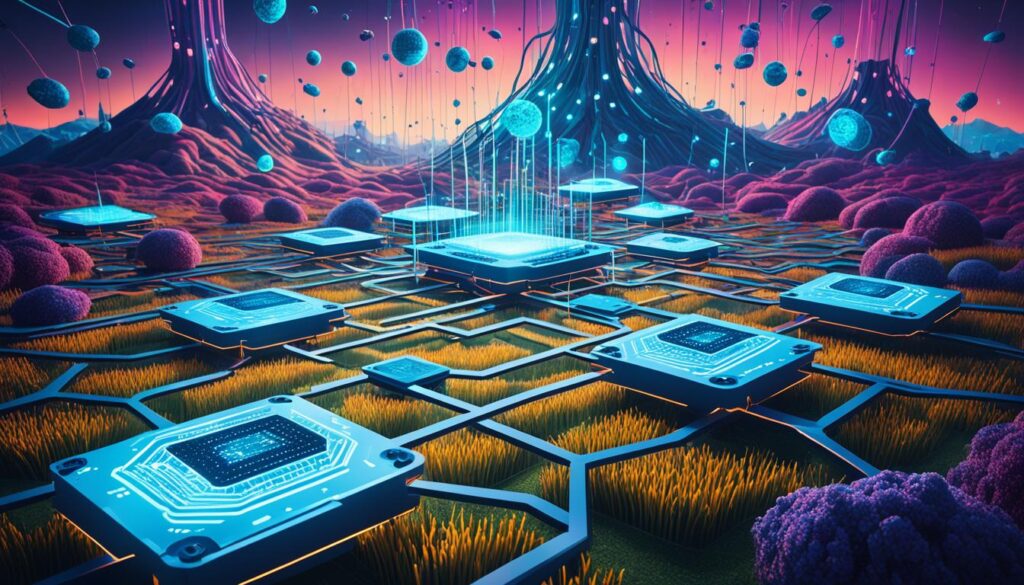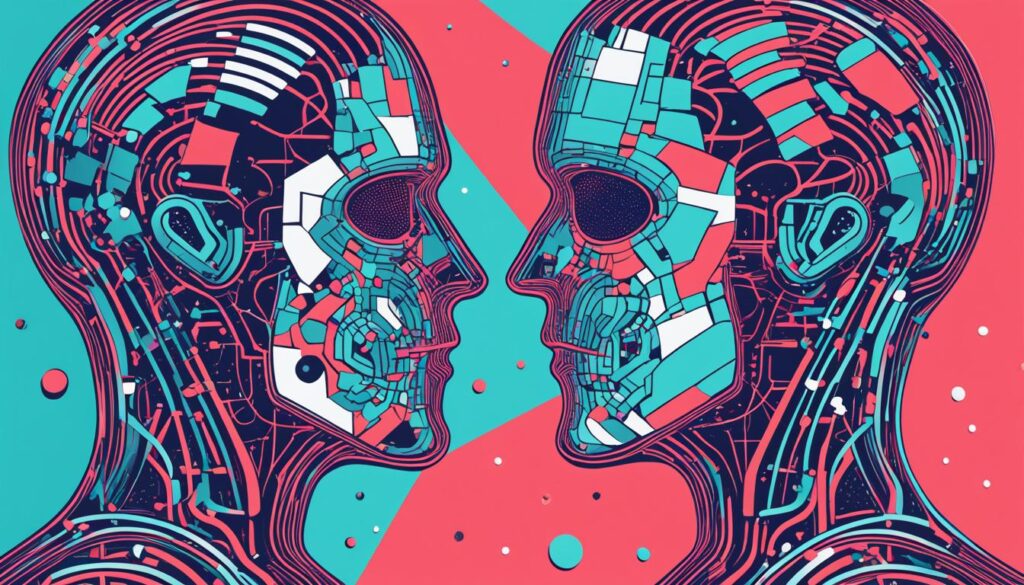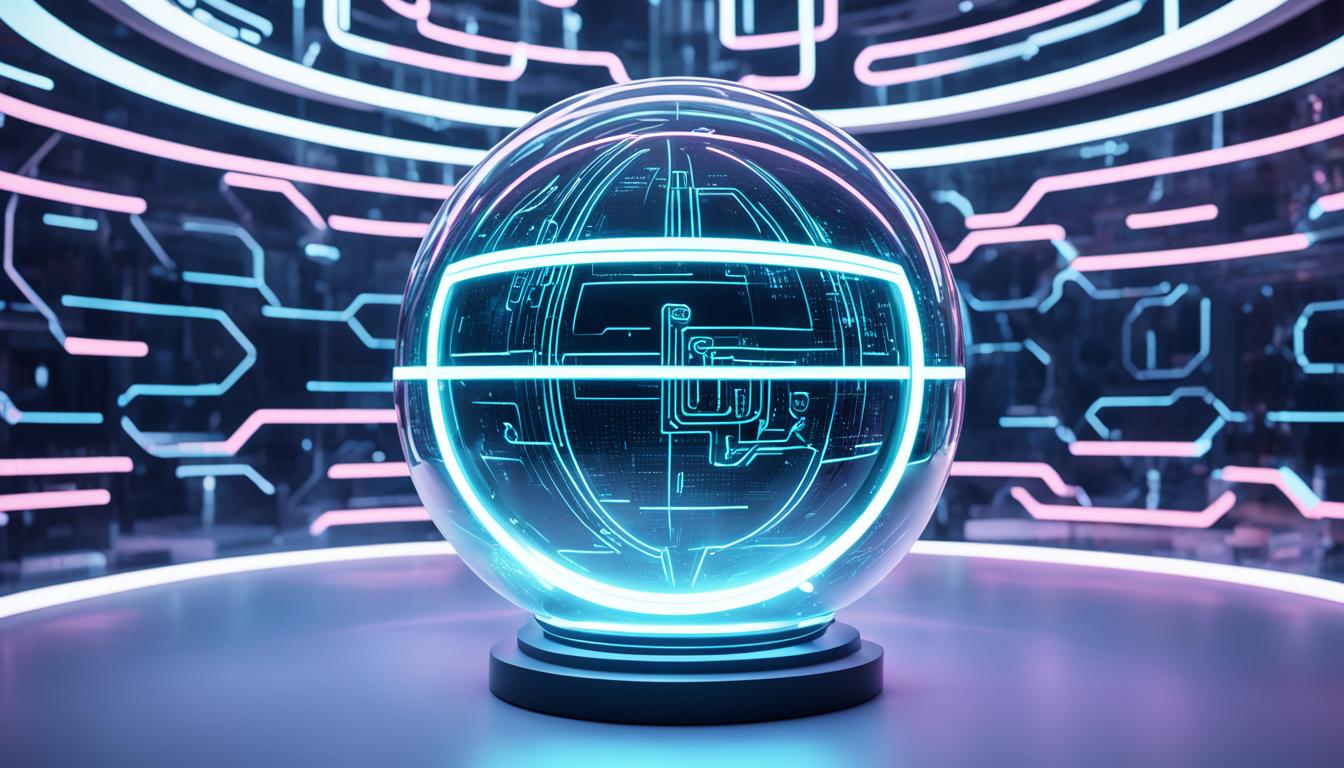“As an Amazon Associate I earn from qualifying purchases.” .
In the world of Artificial Intelligence, it’s key to understand how Conversational AI and Generative AI differ. Conversational AI enables us to chat with devices like Siri, Alexa, and Google Assistant naturally. It uses special tech like natural language processing (NLP), understanding (NLU), and generation (NLG) for human-like talk.
On the flip side, Generative AI is all about making new stuff. This can be anything from articles to songs, pictures, or even 3D designs. It leans on complex machine learning tools, like generative adversarial networks (GANs) and transformer models, such as GPT-4. OpenAI’s ChatGPT is a cool example that blends Conversational with Generative AI for creating text that sounds like a human wrote it.
What really sets them apart is their main purpose. Conversational AI is all about talking and understanding humans. Meanwhile, Generative AI wants to break new ground and make stuff.
Key Takeaways
- Conversational AI, with tools like Siri and Alexa, mimics real chats using NLP, NLU, and NLG.
- Generative AI brings new content to life, using things like GANs and transformers, including GPT-4.
- ChatGPT showcases the fusion of Conversational and Generative AI skills.
- While Conversational AI focuses on interaction, Generative AI is all about creating new things.
- Despite their differences, both branches rely heavily on machine learning to achieve their goals.
Introduction to AI and Generative AI
Artificial Intelligence, or AI, has fundamentally changed how we use machines. It comes in two main types: Traditional AI and Generative AI. Learning the Artificial Intelligence basics is key to understanding its future.
Traditional AI follows established rules to perform tasks. It’s great for analyzing data, making logic-based predictions, and solving problems efficiently. For example, in the 1950s, using a computer for AI cost about $200,000 a month. That shows how much we’ve invested in making AI work for us over the years.
Generative AI is the frontier of AI’s capabilities. It uses machine learning and deep learning to create new things. For instance, GPT-4 by OpenAI can write like a human by learning from a huge amount of online data. It doesn’t just analyze; it can actually create, which helps in making art, music, and even computer codes.
Generative AI Statistics:
- Generative AI can make text, images, music, and code all on its own.
- GPT-4 shows what’s possible with a lot of internet data.
- It’s useful for making designs quickly, writing scripts, and creating deepfakes.
Traditional and Generative AI working together promises a bright future. They blend logical thought with creativity to tackle many industry challenges. This mix will likely lead to more tech innovations and more efficient solutions.
The value of the global AI market has shot up by over $60 billion since 2018. It’s expected to hit $200 billion by 2025. These numbers show how important AI is becoming in our world.
“In 2016, Google’s AlphaGo AI beat a professional Go player, showing what Traditional AI can do. Meanwhile, generative AI has seen breakthroughs like ChatGPT in 2022, changing many areas of work and life.”
In short, diving into Generative AI reveals its power to enhance and expand what Traditional AI can do. Their combination is a big step forward in AI technology, leading us toward a future full of new technological wonders.
Traditional AI: A Brief Overview
Traditional AI is also known as classical AI or Narrow AI. It works on clear-cut rules and algorithms. This makes it predictable. These technologies shine in logical problem-solving, analyzing data, and carrying out instructed tasks. Key aspects in this field include recognizing patterns, processing data, and simple learning algorithms.
Key Technologies in Traditional AI
Traditional AI focuses on rule-based mechanisms. It uses technologies like pattern identification and understanding human language (NLP). These allow the AI to spot data patterns and comprehend inputs in human speech. For instance, Google’s search algorithms and suggestions on Netflix and Amazon showcase this AI in real-world scenarios.
Applications in Various Industries
Traditional AI finds use in many sectors, thanks to its precision and efficiency:
- Healthcare: AI aids in diagnosing and suggesting treatments. This improves patient care and makes clinic work smoother.
- Finance: It helps detect fraud and manages risks. This keeps financial dealings safe and efficient.
- Manufacturing: It forecasts maintenance and enhances processes. This cuts downtime and boosts productivity.
In robotics and chatbots, traditional AI stands out through its rule application and pattern identification. These technologies are crucial in carrying out tasks flawlessly and interacting with customers. Knowing how to use them can greatly help your business.
Interested in how generative AI differs from traditional AI? You might find this article useful.
Understanding Generative AI
Generative AI marks a change from traditional, rule-bound programming. It lets machines use machine creativity in new ways. Unlike typical AI, which does well in narrow tasks like those Siri or Alexa manage, Generative models aim to craft new things using their training data.

Two main methods in this area are Generative Adversarial Networks (GANs) and transformer models. They are great at making completely original content. These models produce works that mirror what they’ve learned, from making human-like text to artwork. For example, OpenAI’s GPT-4 is especially good at writing text that sounds like a person did it.
Implications of Generative AI
- Design: It brings about fast prototyping and fresh product designs.
- Entertainment: It helps in making music, writing scripts, and creating deepfakes.
- Journalism: It supports the making of AI-written content.
Traditional AI is still crucial for jobs that are very specific. It improves many fields with better operational efficiency. Yet, blending traditional AI with Generative AI may unlock new advancements. This could lead to big leaps in technology and creativity.
| Aspect | Traditional AI | Generative AI |
|---|---|---|
| Focus | Specific tasks | Create new data |
| Technologies | NLP, machine learning algorithms | GANs, transformer models |
| Output | Task execution | Novel content |
Knowing the differences and uses of Generative AI and traditional AI is important. They offer a strong set of tools. These tools help solve tough problems and push for innovation in many areas.
Generative AI: A New Paradigm in Artificial Intelligence
Generative AI is changing how we see creativity and innovation in artificial intelligence. It uses advanced tech like deep learning to make new content. This goes from text and images to audio and video. Artificial neural networks are key, using complex models and techniques like RLHF.
Key Technologies in Generative AI
Generative AI’s core is technologies like GANs and transformers. GANs work by having two neural networks compete to create realistic data. On the other hand, transformers handle inputs all at once and include features that keep track of the position of those inputs. This makes models like ChatGPT possible, which understand and generate text much like a human.
Applications in Creative Fields
Generative AI has brought new life to creative fields. In art, it blends computing with human creativity to make stunning visuals. Music sees AI craft unique tunes and complex pieces. Even fashion is getting a makeover with new, bold designs from AI.
In gaming, AI creates detailed worlds and characters. This shows how deep the potential of this technology goes in creativity.
| Key Technology | Core Function | Application |
|---|---|---|
| Generative Adversarial Networks (GANs) | Create realistic data by using two competing networks | Visual art generation, photo-realistic images |
| Transformers | Process inputs in parallel, support positional embeddings | Language models, text generation |
| Large Language Models (LLMs) | Generate human-like text, trained on extensive datasets | Chatbots, content creation |
Generative AI models are quite complex, but they don’t have consciousness or emotions. Yet, they’re great at innovating and solving problems. They’re making big changes in fields like art and music. As they grow, they’ll bring new levels of creativity and efficiency to many industries.
AI vs Generative AI: Key Differences
AI and Generative AI differ a lot, especially in how they solve problems, their data needs, and creativity. Traditional AI, also known as Narrow or Weak AI, follows rules closely. It does well in tasks like data analysis and forecasting.

Approach to Problem Solving
Problem-solving in AI shows a clear contrast between the two. Traditional AI uses set rules and programming. It’s great for logical tasks and specific duties but struggles with new challenges. Generative AI adopts a data-driven strategy. It uses large training datasets to create unique answers and tackle new problems.
Data Requirements and Training
The data needed for Generative AI and Traditional AI is quite different. Traditional AI requires detailed, specific data for tasks like chatbots. Meanwhile, Generative AI needs a lot of varied data for models such as GPT-4. This diversity lets it imitate human creativity, producing new, unheard-of content.
Output and Creativity
Generative AI’s main power is artificial creativity. It can craft new data, like texts or images, similar to what it learned. It’s useful for things like design, entertainment, and journalism. Traditional AI, however, focuses on predictable results, like analytics. Using generative and rule-based AI together could spark innovation in many areas.
| Aspect | Traditional AI | Generative AI |
|---|---|---|
| Problem-Solving Approach | Rule-Based | Data-Centric |
| Data Requirements | Specific and Defined | Extensive and Diverse |
| Output Type | Deterministic | Creative and Novel |
| Main Uses | Data Analysis, Prediction | Creating Original Content |
| Technological Examples | Chatbots, Predictive Analytics | GPT-4, Artistic Creation |
Real-World Applications of Traditional AI
Traditional AI shines in specific tasks, creating big changes in many fields. It excels in pattern recognition, making things faster, more accurate, and efficient. Let’s explore how Traditional AI works in fields like healthcare, finance, and manufacturing.
Examples and Use Cases in Healthcare
The use of AI in healthcare has transformed modern medicine. It makes early disease detection possible, offering clear diagnoses. Machine learning gives customized treatment plans, ensuring patients get what works best for them.
AI also improves how we monitor patients. It lets us watch patient vitals in real-time. This helps with better preventive care and faster responses in emergencies.
Examples and Use Cases in Finance
AI has changed the finance world by solving complex problems. It’s great for spotting fraud by looking at loads of transaction data. This minimizes the risk of losing money. AI also helps in predicting financial risks, making it easier for banks to decide on loans and investments.
AI shines in algorithmic trading too. It analyzes huge datasets quickly, outperforming human traders. This helps in making faster, more informed trading decisions.
Examples and Use Cases in Manufacturing
AI has made a big difference in manufacturing. It checks products on the assembly line for quality through constant inspections. AI predicts when machines will break down. This reduces unexpected stops and lowers maintenance costs.
AI also improves how businesses manage supply chains. It predicts demand, helps keep the right stock levels, and makes buying supplies smoother. This makes the manufacturing process more flexible and efficient.
| Industry | Application | Benefit |
|---|---|---|
| Healthcare | AI-powered diagnostics | Precise disease detection and personalized treatment |
| Finance | Fraud detection | Reduced financial loss through early fraud detection |
| Manufacturing | Predictive maintenance | Minimized downtime and maintenance costs |
Traditional AI’s role in these sectors highlights its value in boosting efficiency, safety, and reliability. By using AI’s strengths, industries keep innovating and improving their operations.
Real-World Applications of Generative AI
Generative AI is making big changes in many fields, especially creative ones. Generative AI in creative industries is changing how we make art and music. It brings new ideas and fosters creativity.
Generative AI is a game-changer in art. It combines tech with human creativity for new artwork. Artists find fresh styles and ideas, breaking conventional limits.
AI has also transformed music creation. AI-generated music is gaining fans for its originality. Musicians use AI for unique songs, exploring new sounds.
In gaming, Generative AI is a big deal. It boosts AI in art and gaming. AI helps create dynamic game worlds and stories. Virtual environment design gets more realistic, enhancing player experience.
Generative AI’s impact goes beyond the arts. It’s key in medicine and finance, helping with research and security. It aids in drug discovery and diagnosing diseases. In finance, it’s used for spotting fraud and making smart trading decisions.
Marketing benefits from AI too. It allows for custom content and better ad performance. This leads to happier customers and more sales. Also, in manufacturing, AI speeds up design and cuts costs, which is great for car and plane makers.
Agriculture is also seeing the benefits of Generative AI. It helps manage crops and fight pests, leading to better harvests. This means more food and improved security.
Comparative Performance of AI vs Generative(rst 2000 characters)
The world of Artificial Intelligence (AI) is rapidly changing. We now see Traditional AI and Generative AI making big impacts across different sectors. About 60% of companies are exploring AI to automate tasks, showing how much they rely on this technology. Generative AI is particularly cool for its ability to create new content, whether it’s writing, pictures, music, or videos.
Bing Chat is a great example of how both Traditional and Generative AI can be used together. It makes images with DALL-E and finds detailed answers to tough questions online. ChatGPT is another good example. It can chat, write essays or songs, and fix coding errors, showing how well Conversational and Generative AI can work together. This combo leads to more accurate answers and happier customers because it can understand and respond to users better than ever before.
There are new tools like Character.ai and Jasper.ai that meet very specific needs. They can help with learning through conversations with historical figures or help writers create unique content. But, even with its creative strengths, Generative AI has had some problems. Early on, it made mistakes and sometimes showed bias, which means there’s still work to do to make it more reliable. While both types of AI are pushing boundaries, whether you choose Traditional or Generative AI depends on what you want to achieve: better efficiency and logic, or more creativity and new ideas.
FAQ
What is the primary distinction between Traditional AI and Generative AI?
How does Conversational AI operate differently from Generative AI?
Can you provide examples of key technologies in Traditional AI?
What are some core technologies that enable Generative AI?
How is AI transforming the healthcare industry?
Could you explain the applications of Generative AI in creative fields?
What are the differences in data requirements between Traditional AI and Generative AI?
What role does technology like GANs play in Generative AI?
How does AI enhance efficiency in the manufacturing sector?
Source Links
- https://www.ilink-digital.com/insights/blog/conversational-vs-generative-ai-decoding-differences/
- https://www.forbes.com/sites/bernardmarr/2023/07/24/the-difference-between-generative-ai-and-traditional-ai-an-easy-explanation-for-anyone/
- https://www.coursera.org/articles/ai-vs-generative-ai
- https://www.fivetran.com/blog/how-generative-ai-different-from-traditional-ai
- https://www.linkedin.com/pulse/generative-ai-practice-real-world-applications-impact-behera
- https://research.aimultiple.com/conversational-ai-vs-generative-ai/
- https://www.techtarget.com/searchenterpriseai/definition/generative-AI
- https://news.ycombinator.com/item?id=33429608
“As an Amazon Associate I earn from qualifying purchases.” .



